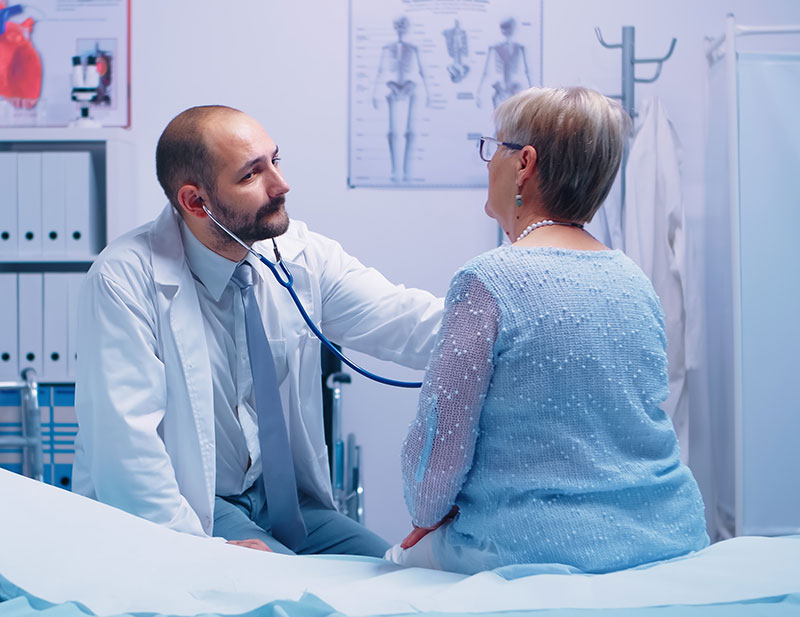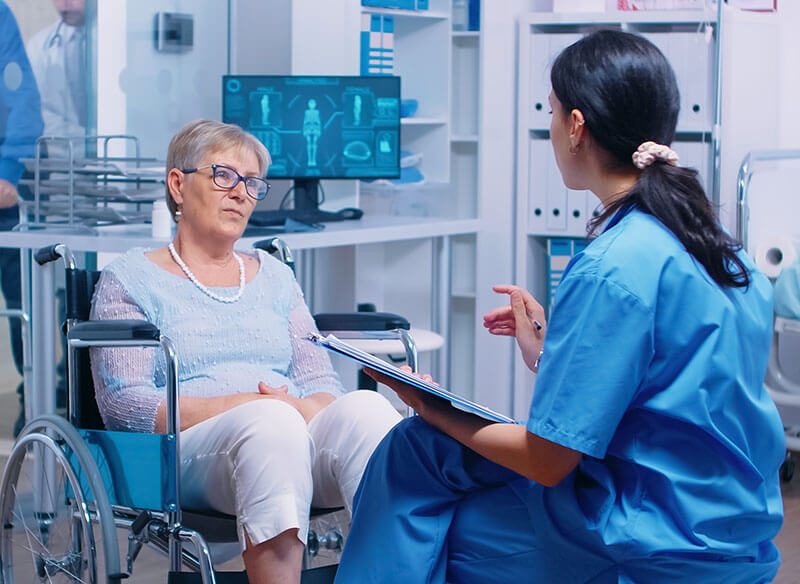Cancer Care & Treatment

Cancer is a group of diseases characterized by uncontrolled cell growth that can invade surrounding tissues and spread to other parts of the body. It can develop in almost any organ or tissue, leading to various types of cancer. Early detection, proper diagnosis, and advanced treatment options are crucial in improving outcomes and survival rates.
Types of Cancer We Treat
Adrenal Cancer
Adrenal cancer is a rare but aggressive disease that affects the adrenal glands, which produce essential hormones. Symptoms may include high blood pressure, weight gain, and hormonal imbalances. Treatment options include surgery, chemotherapy, and targeted therapies.
Blood cancer
Bladder Cancer
Bladder cancer originates in the bladder lining and is often detected through symptoms like blood in urine, frequent urination, and pelvic pain. Treatments may include surgery, immunotherapy, chemotherapy, and radiation therapy.
Bone Cancer
Bone cancer originates in the skeletal system and can be either primary (starting in the bones) or secondary (spreading from another area). Common types include osteosarcoma, which often affects teenagers, and Ewing sarcoma, primarily seen in children and young adults. Symptoms include persistent bone pain, swelling, and an increased risk of fractures. The causes are not always clear, but genetic mutations and radiation exposure may contribute. Treatment often involves a combination of surgery to remove the tumor, chemotherapy to kill cancer cells, and radiation therapy to shrink the tumor and prevent further spread.

Brain Cancer
Brain cancer occurs when abnormal cells grow uncontrollably in the brain. Tumors can be benign (non-cancerous) or malignant (cancerous). The most aggressive type is glioblastoma, while meningiomas are often benign. Symptoms depend on tumor location and may include headaches, seizures, balance problems, memory loss, and vision changes. Causes include genetic factors, radiation exposure, and environmental triggers. Treatment involves surgery, radiation therapy, and chemotherapy. In some cases, targeted therapy is used to attack specific cancer cells. Early diagnosis through MRI or CT scans improves treatment outcomes, but prognosis varies based on tumor type and stage.
Breast Cancer
Breast cancer develops in breast tissue and is one of the most common cancers in women, though men can also be affected. Risk factors include genetic mutations (BRCA1 and BRCA2), hormone levels, and lifestyle choices. Symptoms include a lump in the breast, nipple discharge, and skin dimpling. Early detection through mammograms is crucial for effective treatment. Treatments include surgery (lumpectomy or mastectomy), hormone therapy, chemotherapy, radiation, and targeted therapies like HER2 inhibitors. Advances in research have improved survival rates, particularly when diagnosed early. Regular self-examinations and screenings help detect breast cancer in its initial stages.
Cervical Cancer
Cervical cancer originates in the cervix and is primarily caused by human papillomavirus (HPV) infection. It is one of the most preventable cancers due to HPV vaccines and routine Pap smears that detect abnormal cells early. Symptoms include unusual vaginal bleeding, pelvic pain, and pain during intercourse. Risk factors include multiple sexual partners, smoking, and a weakened immune system. Treatments include surgery (hysterectomy in severe cases), radiation therapy, and chemotherapy. Early-stage cervical cancer is highly treatable, making regular screenings and HPV vaccination vital in reducing incidence rates and improving patient outcomes.
Colon Cancer
Colon cancer begins in the large intestine (colon) and often develops from polyps, which are small clumps of abnormal cells. Routine colonoscopies help detect and remove polyps before they become cancerous. Symptoms include persistent changes in bowel habits, blood in stool, abdominal pain, weight loss, and fatigue. Risk factors include age, a diet high in red or processed meat, obesity, smoking, and genetic predisposition. Treatment options include surgery to remove affected sections of the colon, chemotherapy, radiation therapy, and targeted drug therapy. Early detection significantly improves survival rates, making regular screenings essential for prevention.
Esophageal Cancer
Esophageal cancer affects the esophagus, the tube connecting the throat to the stomach. It is commonly linked to chronic acid reflux (GERD), smoking, heavy alcohol use, and obesity. There are two main types: squamous cell carcinoma (affecting the upper esophagus) and adenocarcinoma (affecting the lower esophagus). Symptoms include difficulty swallowing (dysphagia), unexplained weight loss, chest pain, and persistent heartburn. Diagnosis involves endoscopy and biopsy. Treatments include surgery, radiation therapy, and chemotherapy. When detected early, survival rates improve, but advanced cases often require aggressive treatment for symptom management and prolonged survival.
Gastric (Stomach) Cancer
Gastric cancer develops in the stomach lining and is often diagnosed at later stages due to vague symptoms. Risk factors include Helicobacter pylori (H. pylori) infection, smoking, high-salt diets, and family history. Symptoms include persistent indigestion, nausea, loss of appetite, unexplained weight loss, and stomach pain. Diagnosis involves endoscopy, biopsy, and CT scans. Treatment includes surgery (gastrectomy), chemotherapy, radiation therapy, and targeted therapies for advanced cases. Since early symptoms are mild, routine screenings are essential for early detection, particularly in high-risk individuals, to improve treatment effectiveness.
Gastrointestinal (GI) Cancer
Gastrointestinal (GI) cancer refers to malignancies affecting the digestive system, including the esophagus, stomach, intestines, pancreas, and liver. Symptoms vary by location but often include abdominal pain, nausea, weight loss, and digestive issues. Risk factors include genetics, smoking, excessive alcohol intake, and poor diet. Diagnosis relies on imaging tests, endoscopy, and biopsy. Treatment approaches include surgery (to remove tumors), chemotherapy, radiation therapy, and targeted therapies. Some GI cancers, like pancreatic cancer, are aggressive and diagnosed late, making regular screenings crucial for early intervention and improved survival rates.
Head and Neck Cancer
Head and neck cancers affect the mouth, throat, sinuses, voice box (larynx), and nasal cavity. They are commonly caused by tobacco and alcohol use, HPV infection, and excessive sun exposure (for lip cancer). Symptoms include voice changes, difficulty swallowing, persistent throat pain, non-healing sores, and swollen lymph nodes. Diagnosis includes biopsy, imaging tests, and endoscopy. Treatment depends on the stage and location but often involves surgery, radiation therapy, chemotherapy, and immunotherapy. Early detection significantly improves prognosis. Reducing alcohol and tobacco use and getting HPV vaccination help lower the risk of these cancers.
Liver Cancer
Liver cancer, or hepatocellular carcinoma (HCC), often develops due to chronic hepatitis B/C infections, cirrhosis, excessive alcohol use, and fatty liver disease. Symptoms include jaundice (yellowing of skin and eyes), unexplained weight loss, abdominal swelling, and pain in the upper right abdomen. Diagnosis is done through blood tests (AFP marker), imaging scans (CT/MRI), and biopsy. Treatment options include liver transplantation, surgical tumor removal, targeted therapy, and immunotherapy. Since early liver cancer is often asymptomatic, people at high risk should undergo regular screenings to improve detection and treatment outcomes.
Lung Cancer
Lung cancer is one of the deadliest cancers and is strongly linked to smoking, secondhand smoke, air pollution, and exposure to carcinogens (like asbestos and radon). The two main types are non-small cell lung cancer (NSCLC) and small cell lung cancer (SCLC). Symptoms include persistent cough, coughing up blood, chest pain, shortness of breath, and weight loss. Diagnosis involves CT scans, PET scans, and biopsy. Treatments include surgery, chemotherapy, radiation therapy, targeted drugs, and immunotherapy. Early detection through low-dose CT scans in high-risk individuals can significantly improve survival chances.
Ovarian Cancer
Ovarian cancer often remains undetected until advanced stages due to vague symptoms. Risk factors include genetic mutations (BRCA1/BRCA2), family history, hormonal factors, and obesity. Symptoms include bloating, pelvic pain, frequent urination, and loss of appetite. Diagnosis involves pelvic exams, ultrasound, CA-125 blood tests, and biopsy. Treatment includes surgery (removal of ovaries and affected tissue), chemotherapy, and targeted therapies. Early detection is challenging, so women at high risk should undergo genetic testing and regular screenings. Although treatment advances have improved survival rates, late detection remains a major challenge.
Pancreatic Cancer
Pancreatic cancer is one of the most aggressive cancers, often diagnosed in late stages. Risk factors include chronic pancreatitis, smoking, diabetes, and genetic predisposition. Symptoms include jaundice, severe abdominal pain, unexplained weight loss, and digestive problems. Diagnosis involves CT/MRI scans, biopsy, and blood markers (CA 19-9 test). Treatments include surgery (Whipple procedure), chemotherapy, radiation therapy, and targeted therapy. Since early detection is difficult, survival rates remain low. Research is ongoing to develop better screening methods for early diagnosis, as timely intervention can improve patient outcomes.
Prostate Cancer
Prostate cancer is one of the most common cancers in men, usually affecting those over 50. It develops in the prostate gland, which produces seminal fluid. Risk factors include age, family history, African ancestry, and diet. Symptoms often appear late and may include difficulty urinating, weak urine flow, blood in urine or semen, and pelvic pain. Diagnosis involves PSA (prostate-specific antigen) blood tests, digital rectal exams (DRE), and biopsies. Treatment options vary from active surveillance for slow-growing cases to surgery, radiation therapy, hormone therapy, and chemotherapy for advanced stages. Early detection improves treatment success and survival rates.
Rectal Cancer
Rectal cancer affects the rectum, the last section of the large intestine. It is similar to colon cancer, often arising from polyps that become cancerous. Risk factors include age, diet high in processed meats, inflammatory bowel disease, smoking, and genetic predisposition. Symptoms include rectal bleeding, changes in bowel habits, persistent abdominal pain, and unexplained weight loss. Diagnosis is made through colonoscopy, biopsy, and imaging tests. Treatment includes surgery (to remove the tumor), radiation therapy, chemotherapy, and targeted drug therapy. Early detection through regular screenings significantly improves survival rates and reduces the need for extensive treatment.
Renal (Kidney) Cancer
Renal cancer, or kidney cancer, originates in the kidneys, which filter waste from the blood. The most common type is renal cell carcinoma (RCC). Risk factors include smoking, high blood pressure, obesity, genetic conditions, and long-term dialysis. Symptoms often appear late and include blood in urine, back pain, unexplained weight loss, and fatigue. Diagnosis involves imaging scans (CT/MRI), urine tests, and biopsies. Treatment includes surgery (nephrectomy to remove affected kidney parts), immunotherapy, targeted drug therapy, and radiation. Early-stage renal cancer has a high survival rate, making routine checkups and imaging tests important for early detection.
Skin Cancer
Skin cancer develops due to uncontrolled growth of abnormal skin cells, primarily caused by UV radiation from the sun or tanning beds. The three main types are basal cell carcinoma (BCC), squamous cell carcinoma (SCC), and melanoma, with melanoma being the most aggressive. Symptoms include new or changing moles, skin lesions, or sores that don’t heal. Diagnosis involves skin examinations and biopsies. Treatments include surgical removal, radiation therapy, immunotherapy, and targeted drugs. Wearing sunscreen, avoiding excessive sun exposure, and regular skin checkups can prevent skin cancer or detect it early, improving survival rates.
Testicular Cancer
Testicular cancer primarily affects young men aged 15-35 and originates in the testicles, which produce sperm and hormones. It is highly treatable, even in advanced stages. The main types are seminomas and non-seminomas. Risk factors include undescended testicles, family history, and HIV infection. Symptoms include swelling, lumps, pain in the testicles or groin, and fluid buildup in the scrotum. Diagnosis involves ultrasound, blood tests for tumor markers (AFP, hCG), and biopsy. Treatment includes surgery (orchiectomy to remove the affected testicle), chemotherapy, and radiation therapy. Regular self-examinations help detect lumps early, improving survival rates.
Thyroid Cancer
Thyroid cancer affects the thyroid gland, which regulates metabolism and hormone production. The main types include papillary, follicular, medullary, and anaplastic thyroid cancer. Risk factors include radiation exposure, iodine deficiency, and genetic mutations. Symptoms include lumps in the neck, voice changes, difficulty swallowing, and swollen lymph nodes. Diagnosis is made through ultrasound, fine-needle biopsy, and blood tests. Treatment includes surgery (thyroidectomy), radioactive iodine therapy, hormone replacement therapy, and targeted drugs. Most thyroid cancers are highly treatable, especially when detected early. Regular neck self-exams and screenings help with early identification.
Uterine Cancer
Uterine cancer, or endometrial cancer, originates in the lining of the uterus (endometrium). It is most common in postmenopausal women. Risk factors include obesity, hormone imbalances (high estrogen levels), polycystic ovary syndrome (PCOS), and tamoxifen use. Symptoms include abnormal vaginal bleeding, pelvic pain, pain during intercourse, and unexplained weight loss. Diagnosis involves pelvic exams, ultrasound, endometrial biopsy, and hysteroscopy. Treatment includes surgery (hysterectomy), radiation therapy, hormone therapy, and chemotherapy. Regular gynecological checkups help detect the disease early, improving treatment success and long-term prognosis.
